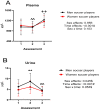Sex Differences in Copper Concentrations during a Sports Season in Soccer Players
- PMID: 36771202
- PMCID: PMC9921014
- DOI: 10.3390/nu15030495
Sex Differences in Copper Concentrations during a Sports Season in Soccer Players
Abstract
Physical training produces changes in the concentrations of trace mineral elements. Sex differences in copper (Cu) concentrations in athletes are scarce. The objectives of this study were (i) to analyze changes in intracellular (erythrocytes and platelets) and extracellular (plasma and urine) Cu concentrations during a sports season in soccer players and (ii) to analyze sex differences. A total of 46 soccer players (22 men and 24 women) participated in the study. Three assessments were performed throughout the sports season. Anthropometry, body composition, nutritional intake, physical condition, female hormones (menstrual cycle) and hematology were evaluated, as well as Cu determination (plasma, urine, erythrocytes, and platelets). Regarding longitudinal differences, there were discrepancies in plasma, urine, absolute erythrocyte, and absolute platelet Cu concentrations (p < 0.05). There were differences between sexes in Cu concentrations in urine, erythrocytes relative to cell number and in platelets relative to cell number (p < 0.05). During a sports season, there are changes in Cu concentrations in soccer players. Likewise, there could be sex differences in urinary, erythrocyte and platelet Cu concentrations.
Keywords: erythrocytes; plasma; platelets; soccer; urine.
Conflict of interest statement
The authors declare no conflict of interest.
Figures


Similar articles
-
Changes in Hematological Parameters of Iron Status and Total Iron Concentrations in Different Biological Matrices during a Sports Season in Women's Soccer Players.Nutrients. 2023 Apr 11;15(8):1833. doi: 10.3390/nu15081833. Nutrients. 2023. PMID: 37111051 Free PMC article.
-
Selenium Concentrations in Soccer Players During a Sports Season: Sex Differences.Nutrients. 2025 Jul 8;17(14):2257. doi: 10.3390/nu17142257. Nutrients. 2025. PMID: 40732882 Free PMC article.
-
Plasma, Urinary, Erythrocyte and Platelet Zinc Concentrations in Soccer Players.Nutrients. 2024 Aug 21;16(16):2789. doi: 10.3390/nu16162789. Nutrients. 2024. PMID: 39203924 Free PMC article.
-
Detrimental Effects of the Off-Season in Soccer Players: A Systematic Review and Meta-analysis.Sports Med. 2021 Apr;51(4):795-814. doi: 10.1007/s40279-020-01407-4. Epub 2021 Jan 5. Sports Med. 2021. PMID: 33400214
-
Carbohydrate Consumption and Periodization Strategies Applied to Elite Soccer Players.Curr Nutr Rep. 2020 Dec;9(4):414-419. doi: 10.1007/s13668-020-00338-w. Epub 2020 Oct 24. Curr Nutr Rep. 2020. PMID: 33098050 Review.
Cited by
-
Aluminum Concentrations in Male and Female Football Players during the Season.Toxics. 2023 Nov 10;11(11):920. doi: 10.3390/toxics11110920. Toxics. 2023. PMID: 37999572 Free PMC article.
-
Changes in Hematological Parameters of Iron Status and Total Iron Concentrations in Different Biological Matrices during a Sports Season in Women's Soccer Players.Nutrients. 2023 Apr 11;15(8):1833. doi: 10.3390/nu15081833. Nutrients. 2023. PMID: 37111051 Free PMC article.
-
Unveiling the Origin of Copper Accumulation in Plasma with Aging.Environ Health (Wash). 2024 Sep 11;3(1):58-67. doi: 10.1021/envhealth.4c00096. eCollection 2025 Jan 17. Environ Health (Wash). 2024. PMID: 39839250 Free PMC article.
-
Selenium Concentrations in Soccer Players During a Sports Season: Sex Differences.Nutrients. 2025 Jul 8;17(14):2257. doi: 10.3390/nu17142257. Nutrients. 2025. PMID: 40732882 Free PMC article.
References
-
- Wolinsky I., Driskell J. Sports Nutrition: Vitamins and Trace Elements. CRC Press; Boca Raton, FL, USA: 2005.
MeSH terms
Substances
LinkOut - more resources
Full Text Sources

